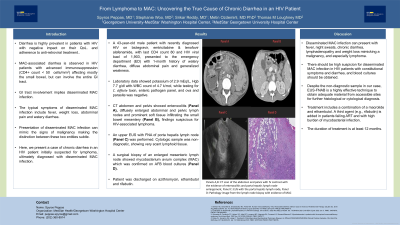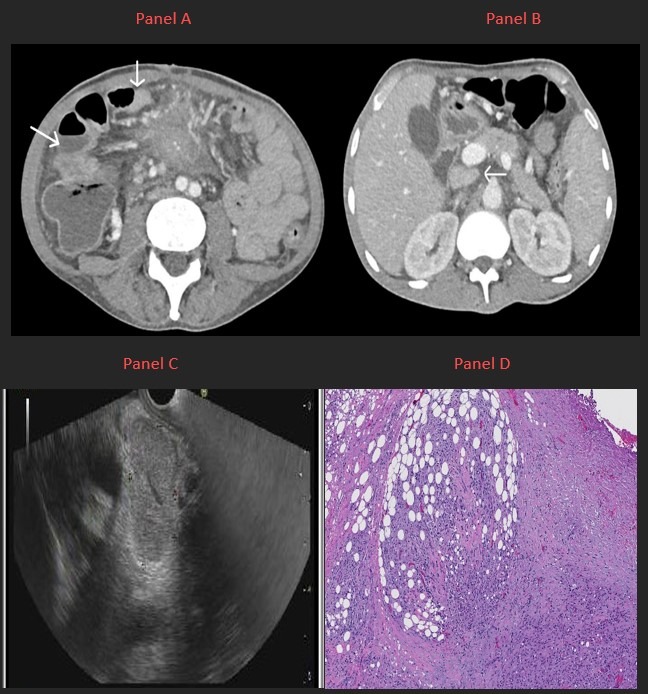Tuesday Poster Session
Category: Small Intestine
P4974 - From Lymphoma to MAC: Uncovering the True Cause of Chronic Diarrhea in an HIV Patient
Tuesday, October 29, 2024
10:30 AM - 4:00 PM ET
Location: Exhibit Hall E

Has Audio
- SP
Spyros Peppas, MD
MedStar Health-Georgetown/Washington Hospital Center
Washington, DC
Presenting Author(s)
Spyridon Peppas, MD1, Stephanie M. Woo, MD2, Srikar Reddy, MD2, Metin Ozdemirli, MD, PhD2, Thomas M. Loughney, MD2
1MedStar Health-Georgetown/Washington Hospital Center, Washington, DC; 2MedStar Georgetown University Hospital, Washington, DC
Introduction: Diarrhea in patients with human immunodeficiency virus (HIV) infection can stem from various causes, including infections, malignancies, and medications. Despite reduced infectious diarrhea rates with anti-retroviral treatment (ART), non-adherence can lead to advanced HIV with opportunistic infections. Mycobacterium avium complex (MAC) infection can be encountered in patients with advanced HIV and CD4 count < 50 cells/mm3. Here, we present a case of chronic diarrhea in an HIV patient initially suspected for lymphoma, ultimately diagnosed with disseminated MAC infection.
Case Description/Methods: A 43-year-old male patient with recently diagnosed HIV on bictegravir, emtricitabine & tenofovir alafenamide, with last CD4 count 80 and HIV viral load of 1,903, presented to the emergency department (ED) with 1-month history of watery diarrhea, diffuse abdominal pain and generalized weakness. The patient was hemodynamically stable, while laboratory data was remarkable for a showed potassium of 2.9 mEq/L,and Hgb 7.7 g/dl with WBC count of 4.7 k/mcL negative C. difficile toxin, enteric pathogen panel, and ova and parasite exam. CT abdomen and pelvis showed enterocolitis (Panel A), diffusely enlarged abdominal and pelvic lymph nodes and prominent soft tissue infiltrating the small bowel mesentery (Panel B), findings suspicious for HIV-associated lymphoma. An upper EUS with FNA of porta hepatis lymph node (Panel C) was performed. Cytologic sample was non-diagnostic, showing very scant lymphoid tissue. Patient underwent a surgical biopsy of an enlarged mesenteric lymph node. The biopsy showed mycobacterium avium complex (MAC) which was confirmed on AFB blood cultures (Panel D). He was discharged on azithromycin, ethambutol and rifabutin.
Discussion: MAC infection often manifests among HIV patients with a CD4 count < 50 cells/mm3. The gastrointestinal tract frequently serves as a primary site of MAC entry in individuals with AIDS. Given overlapping symptoms, distinguishing between lymphoma and MAC can be challenging, necessitating a biopsy to discern the accurate diagnosis. We present this case to underscore the significance of MAC enterocolitis as a notable cause of chronic diarrhea in patients with advanced HIV, and also highlight the difficulty in differentiating it clinically from other causes of diarrhea in this population. Patients with colonization of the gastrointestinal (GI) tract with MAC are at a higher risk of developing MAC bacteremia and early diagnosis can reduce the morbidity and mortality.

Disclosures:
Spyridon Peppas, MD1, Stephanie M. Woo, MD2, Srikar Reddy, MD2, Metin Ozdemirli, MD, PhD2, Thomas M. Loughney, MD2. P4974 - From Lymphoma to MAC: Uncovering the True Cause of Chronic Diarrhea in an HIV Patient, ACG 2024 Annual Scientific Meeting Abstracts. Philadelphia, PA: American College of Gastroenterology.
1MedStar Health-Georgetown/Washington Hospital Center, Washington, DC; 2MedStar Georgetown University Hospital, Washington, DC
Introduction: Diarrhea in patients with human immunodeficiency virus (HIV) infection can stem from various causes, including infections, malignancies, and medications. Despite reduced infectious diarrhea rates with anti-retroviral treatment (ART), non-adherence can lead to advanced HIV with opportunistic infections. Mycobacterium avium complex (MAC) infection can be encountered in patients with advanced HIV and CD4 count < 50 cells/mm3. Here, we present a case of chronic diarrhea in an HIV patient initially suspected for lymphoma, ultimately diagnosed with disseminated MAC infection.
Case Description/Methods: A 43-year-old male patient with recently diagnosed HIV on bictegravir, emtricitabine & tenofovir alafenamide, with last CD4 count 80 and HIV viral load of 1,903, presented to the emergency department (ED) with 1-month history of watery diarrhea, diffuse abdominal pain and generalized weakness. The patient was hemodynamically stable, while laboratory data was remarkable for a showed potassium of 2.9 mEq/L,
Discussion: MAC infection often manifests among HIV patients with a CD4 count < 50 cells/mm3. The gastrointestinal tract frequently serves as a primary site of MAC entry in individuals with AIDS. Given overlapping symptoms, distinguishing between lymphoma and MAC can be challenging, necessitating a biopsy to discern the accurate diagnosis. We present this case to underscore the significance of MAC enterocolitis as a notable cause of chronic diarrhea in patients with advanced HIV, and also highlight the difficulty in differentiating it clinically from other causes of diarrhea in this population. Patients with colonization of the gastrointestinal (GI) tract with MAC are at a higher risk of developing MAC bacteremia and early diagnosis can reduce the morbidity and mortality.

Figure: Panels A,B: CT scan of the abdomen and pelvis with IV contrast with the evidence of enterocolitis and porta hepatis lymph node enlargement,
Panel C: EUS with the porta hepatis lymph node, Panel D: Pathology image from the lymph node biopsy with evidence of MAC
Panel C: EUS with the porta hepatis lymph node, Panel D: Pathology image from the lymph node biopsy with evidence of MAC
Disclosures:
Spyridon Peppas indicated no relevant financial relationships.
Stephanie Woo indicated no relevant financial relationships.
Srikar Reddy indicated no relevant financial relationships.
Metin Ozdemirli indicated no relevant financial relationships.
Thomas Loughney indicated no relevant financial relationships.
Spyridon Peppas, MD1, Stephanie M. Woo, MD2, Srikar Reddy, MD2, Metin Ozdemirli, MD, PhD2, Thomas M. Loughney, MD2. P4974 - From Lymphoma to MAC: Uncovering the True Cause of Chronic Diarrhea in an HIV Patient, ACG 2024 Annual Scientific Meeting Abstracts. Philadelphia, PA: American College of Gastroenterology.
